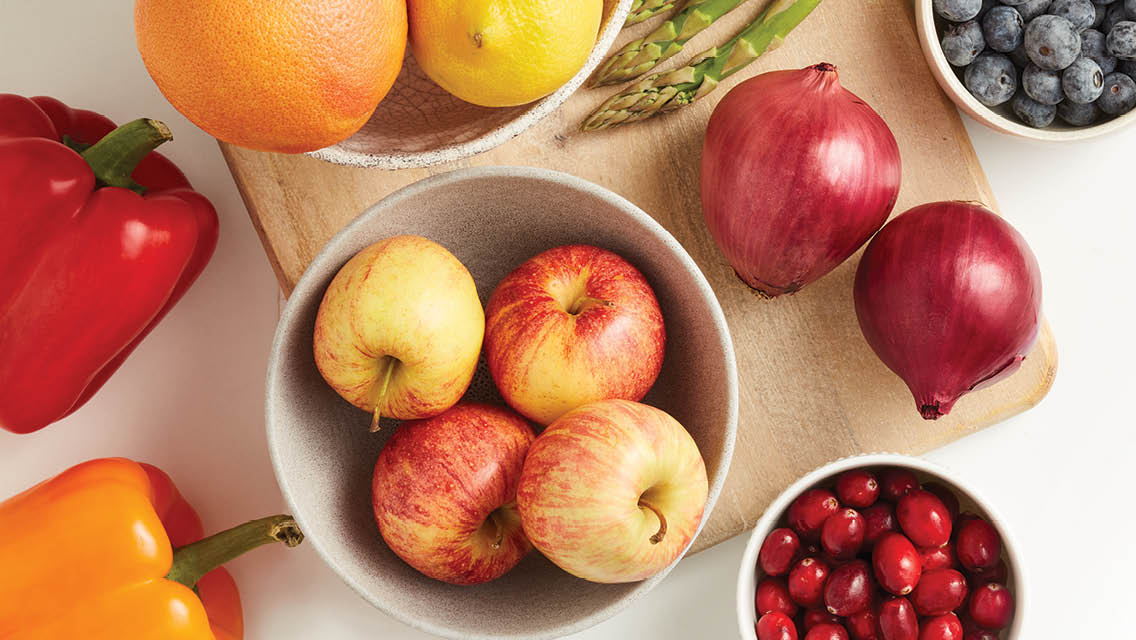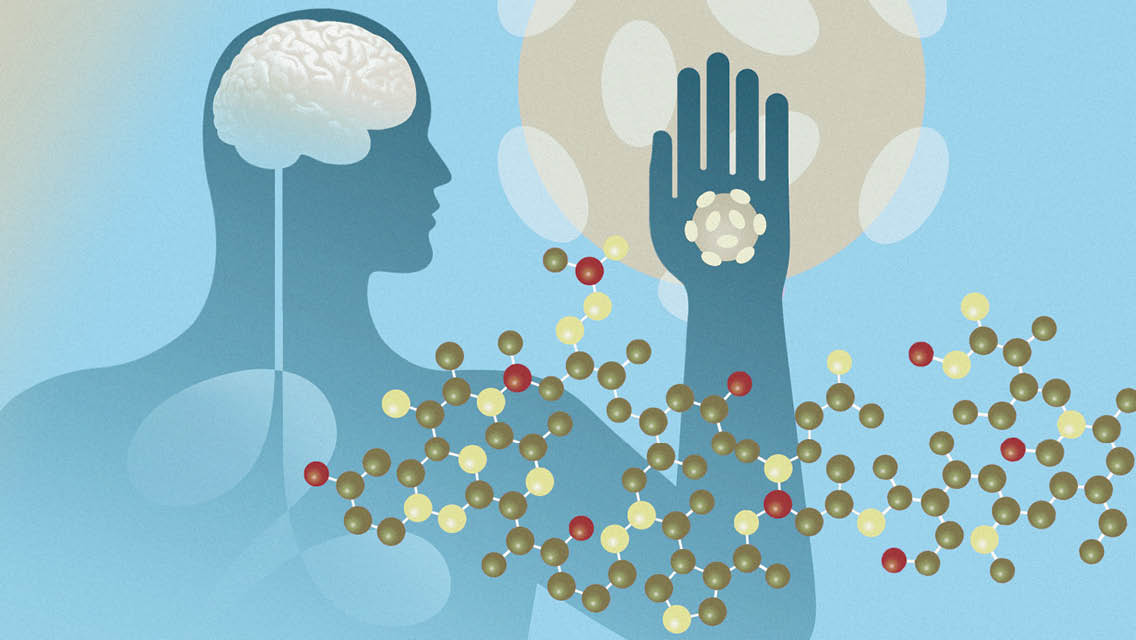Explore this article:
The Allergic Alarm ⋅ Where to Find Quercetin ⋅ Other Benefits of Quercetin ⋅ 7 Sources of Allergy Relief
Ah, spring! Time to open the windows and welcome in the fresh air.
Well, maybe.
If you’re among the more than 50 million people in the United States with allergic rhinitis, better known as allergies, spring can be a miserable time. Pollen from trees, grasses, and weeds can trigger itchy eyes, nasal congestion, and other indignities. Spring’s arrival may make you more likely to close up the house and submit to a groggy few months of allergy medication.
Yet many integrative– and functional-medicine practitioners believe there are better — and safer — options. “Inhaled, nasal, and topical steroids are very handy and effective, but they’re not without adverse effects,” says functional-medicine physician Gregory Plotnikoff, MD, MTS, FACP.
The occasional use of anticholinergic, antihistamine drugs isn’t likely to lead to problems aside from drowsiness, but long-term use may be another story. “Anticholinergic drugs such as Benadryl act by blocking a neurotransmitter in our brains called acetylcholine, which is involved in allergic reactions — as well as learning and memory,” explains naturopathic practitioner Kara Fitzgerald, ND, IFMCP.
She points to a study published in JAMA Internal Medicine in 2015 indicating drugs with anticholinergic effects may increase the risk of dementia. Other studies also suggest there may be a connection between long-term use of these medications and cognitive decline.
Further, says Fitzgerald, “antihistamine medications don’t address the root cause of immune dysfunction, which, if left unaddressed, can promote further immune dysregulation and development of other sensitivities.” (Learn more about the functional-medicine approach to treating allergies at
“Taking On the Allergy Epidemic“.)
Fortunately, drugs are not your only option. You can support your immune system and relieve the misery of seasonal-allergy symptoms through targeted nutrition.
One especially useful nutrient to consider is quercetin. This natural antihistamine can provide drug-free relief, both from seasonal-allergy symptoms and from allergic reactivity to perennial triggers, such as dust and dander.
The Allergic Alarm
Nutritionally, quercetin is classified as a flavonoid — a group of naturally occurring compounds that give vegetables, fruits, and flowers their colorful hues. Flavonoids also act as antioxidants, which neutralize the oxidative stress behind virtually all chronic disease.
To understand how quercetin reduces allergic reactivity, consider how allergens activate our immune systems. In sensitized people, pollen and other substances in our environment trigger the production of IgE antibodies. These immune molecules cause mast cells and basophils to release histamine and other allergy-mediating molecules.
Mast cells are in all parts of the body that come into contact, directly or indirectly, with the outside world — eyes, ears, sinuses, mouth, throat, gastrointestinal tract, and skin. Imagine these as sentinels on a ship scanning the horizon for icebergs, or in a tower scouting for forest fires, Plotnikoff suggests. “If they detect something, they sound the alarm.”
Drugs are not your only option. You can support your immune system and relieve the misery of seasonal-allergy symptoms through targeted nutrition.
This alarm leads to inflammation of nasal passages and eyes, as well as itching, swelling, and mucus production. But the response doesn’t end here.
Histamine molecules dock at receptor sites in these affected areas, triggering mast cells to keep releasing histamine and other chemicals. “This is where people get stuck in a nonresolving, detrimental, proinflammatory loop,” Plotnikoff says.
Quercetin helps relieve these symptoms by stabilizing the mast-cell membranes, which inhibits histamine release. “It interrupts the loop,” he adds. “It raises the threshold by which mast cells would release more histamines and other chemicals.”
This nonsteroidal way of moderating histamine response takes a while to get up to speed, he adds. It can be several weeks before the effects kick in. “So, it’s not going to be nearly as quick as taking a Zyrtec or a Benadryl, which actually block the histamine receptor.”
While a lot of research has been done on quercetin, it’s mostly been in lab environments rather than clinical ones. But Plotnikoff and other practitioners consider this research in the context of clinical observation and patient reporting as well.
“Quercetin is well known and overall safe,” he says. “It represents a logical option for those who would prefer not to take medications.”
Where to Find Quercetin
If you’re already eating a plant-forward, rainbow-colored diet, you’re likely getting quercetin nearly every day. It’s found in colorful produce, including red onions, dark cherries, cranberries, blueberries, blackberries, and grapes. Apples (with the skin), citrus fruits, and yellow onions are also good sources of quercetin, as are broccoli, spinach, kale, asparagus, peppers, scallions, and fennel.
“Capers, in particular, are off the charts compared with other foods for their quercetin content — they are a quercetin superfood!” says Fitzgerald.
You can find the nutrient in your morning tea — especially green, black, and oolong — and in your evening red wine as well.
Herbs (including parsley, sage, thyme, oregano, chives, and dill) are good sources, too.
Still, the bioavailability of quercetin varies widely among foods, says Plotnikoff. Onions deliver more bioavailable quercetin than apples, for example. Because quercetin is a lipophilic compound (meaning it dissolves more easily in fat than water), pairing these foods with dietary fat — think cooking onions in olive oil — may improve absorption. “A salad with olive oil would also be ideal,” he says.
“I always encourage people to focus on food first for quercetin absorption,” adds functional dietitian Cindi Lockhart, RDN, LD, IFNCP, but she notes that “there’s a lower potency. When you talk about therapeutic doses, you almost have to supplement.”
If you’re trying to reduce your dependence on allergy medication, Lockhart says, try synergistic quercetin supplements that include nutrients such as bromelain, an enzyme mixture found in pineapples that can enhance the body’s ability to absorb quercetin.
If you’re trying to reduce your dependence on allergy medication, Lockhart says, try synergistic quercetin supplements that include nutrients such as bromelain, an enzyme mixture found in pineapples that can enhance the body’s ability to absorb quercetin.
She explains that many supplements have a “loading dose,” to be taken initially. As you notice a dampening of symptoms, you can reduce to a lower “maintenance dose.” (Turn to a healthcare provider for dosage guidance. Also, some providers recommend starting supplements well before pollen season begins, to prevent symptoms.)
You may even be able to wean yourself from pharmaceutical support altogether.
“It usually takes a few weeks before you notice improvements, during which time you may still need to use antihistamine medications if your symptoms are severe enough to impede your daily activities,” says Fitzgerald. “However, after that time you may start to notice reduced symptoms and have less or no need for medication.”
Beyond Allergies: Other Benefits of Quercetin
In addition to helping tame the allergy response, quercetin has anti-inflammatory, antiviral, and anticancer properties, and it provides mitochondrial protection, says Gregory Plotnikoff, MD, MTS, FACP. Its protective and therapeutic potential keeps researchers busy investigating its ability to support a range of health conditions.
- Brain health: Several studies have identified quercetin’s neuroprotective benefits. As an antioxidant, it may mitigate age-related degenerative processes, for example, and its anti-inflammatory properties may protect against the progression of inflammation-mediated neurodegenerative disorders.
- Heart health: Along with other flavonoids, such as resveratrol and catechins, quercetin may help reduce the risk of atherosclerosis, the plaque accumulation in arteries that can lead to heart attack and stroke. It may also prevent damage from LDL cholesterol and reduce blood pressure in people with hypertension.
- Cancer: In lab studies, quercetin has inhibited many types of cancer cells. Plotnikoff cautions, however: “In some types of cancers, quercetin enhances the activity of chemotherapy, and in others it actually blocks the effectiveness of chemotherapy.”
- COVID-19: The Institute for Functional Medicine notes that “quercetin has been shown to have antiviral effects against both RNA viruses (e.g., influenza and coronavirus) and DNA viruses (e.g., herpes).” Although clinical evidence is limited, says Plotnikoff, “for some people, quercetin has been helpful for both acute and long COVID.”
7 Sources of Allergy Relief
To address allergies, “one of the most powerful leverage points we have is diet,” says Kara Fitzgerald, ND, IFMCP, who recommends a whole-foods diet with plenty of colorful vegetables and fruits, herbs and spices, nuts and seeds, and fish rich in omega-3 fatty acids. She also suggests avoiding inflammatory foods that can drive allergy symptoms, including sugars, refined grains, vegetable oils, trans fats, and processed foods.
Several botanicals may support you during allergy season. “They usually take a little longer to act than medications, and you must be consistent about taking them before and during allergy seasons, but they are much safer for long-term use,” she says.
Consider adding these to your antiallergy arsenal:
1. Vitamin C
With its antioxidant and anti-inflammatory properties, vitamin C supports immune function and has also been shown to reduce the amount of histamine your body produces in response to allergen exposure. “Since allergies are an immune-system response, it makes sense that adequate vitamin C is important,” says Life Time master trainer and dietitian Samantha McKinney, RDN, LD. “Most studies are done on intravenous vitamin C, but taking it orally can still help boost your vitamin C status.”
Best Food Sources:
Humans don’t make or store vitamin C, so eat plenty of your favorite citrus fruits, peppers, green leafy vegetables, and berries.
How to Supplement:
For extra support during allergy season, Cindi Lockhart, RDN, LD, IFNCP, recommends a liposomal form of vitamin C for optimal absorption. Try 500 mg twice a day “up to bowel tolerance,” she says. If you’re still having allergy symptoms and your stools are fine, increase gradually to as much as 2,000 mg a day.
(See “What You Need to Know About Vitamin C” for more on this essential nutrient that supports nearly every aspect of health.)
2. Stinging Nettle
A long-revered herbal remedy, stinging nettle contains quercetin and other flavonoids as well as a host of vitamins, including vitamin C. Research is limited, but studies suggest it may reduce seasonal-allergy symptoms by acting as an anti-inflammatory and antihistamine. More long-term human studies are needed to confirm efficacy and safety.
Best Food Sources:
You can find stinging-nettle tinctures and capsules at most natural grocery stores and pharmacies. Some people make a tea or tincture from dried leaves or flowers, or add roots to soups. “I would not recommend making a tincture on your own unless you’re an experienced herbalist or professional,” cautions McKinney.
How to Supplement:
“The most common dose for allergies is 300 mg twice daily for a total of 600 mg of a supplement from the stinging-nettle leaf, not the root,” says McKinney.
3. Bromelain
This enzyme mixture is known for its support of digestion as well as its inflammation-fighting properties. Research suggests bromelain may shorten the duration of acute-sinusitis symptoms, improve breathing, and reduce nasal inflammation. It’s also used with supplemental quercetin to increase absorption.
Best Food Sources:
Bromelain is found in fresh pineapple, but not in therapeutic doses. Still, the fruit is rich in antioxidants and immune-boosting nutrients, including vitamin C, which support allergy-symptom relief.
How to Supplement:
“Bromelain is typically taken as a capsule or tablet, but it’s also available as a powder,” says McKinney. She notes that it can cross-react with certain medications, so check with your physician if you’re taking prescriptions, especially antibiotics, blood thinners, sleep aids, or antidepressants.
4 & 5. Probiotics and Prebiotics
With 70 to 80 percent of our immune cells living in the gut — and an increasing understanding of how the gut microbiome affects systemic immunity — it makes sense to feed and repopulate our microbiota to reduce allergic reactivity. Several studies have shown that probiotic support can improve symptoms of allergic rhinitis.
Best Food Sources:
“Food is how you really shift things in the microbiome,” says Lockhart, noting that “a supplement is more like a placeholder.” Probiotic foods that populate your gut with healthy bacteria are fermented fare, such as natural sauerkraut, kimchi, yogurt, miso, and kombucha. Prebiotic foods — which feed the bacteria in your gut — include asparagus, cabbage, garlic, Jerusalem artichokes, and onions.
How to Supplement:
McKinney suggests that a broad-spectrum probiotic supplement may be helpful for allergies. “I typically recommend both food-based strategies and periodic probiotic supplementation. Look for options that have at least 30 billion CFU (colony-forming units) that include both Lactobacillus and Bifidobacterium species.”
(Learn more at “Everything You Need to Know About Probiotics” and “Why Prebiotics Are as Important as Probiotics.”)
6. Vitamin D
Researchers have long recognized vitamin D’s role in supporting immune health, and more recent studies suggest that people with low serum vitamin D levels may have an increased risk of allergic rhinitis.
A small 2015 placebo-controlled trial of vitamin D supplementation found that allergic-rhinitis patients who took vitamin D had significantly improved nasal symptoms after supplementation.
Best Food Sources:
Eggs and fatty fish, such as salmon, sardines, and mackerel (with bones for the most nutritional benefit), are excellent sources of vitamin D.
Still, “the average person is not going to see a big bump in their vitamin D levels from food alone, especially if they’re deficient,” says McKinney, who recommends some common-sense exposure to the sun, as well as supplementation.
How to Supplement:
Look for vitamin D3, which is more bioavailable than D2. Taking vitamin K2 with your D3 provides synergistic benefits.
(Find out more about vitamin D supplementation at “Vitamin D: What You Need to Know“.)
7. Black Cumin Seed
Nigella sativa (N. sativa), also known as black cumin seed, has a long history as a traditional food and folk medicine. Limited but promising research suggests the seed’s antihistamine, anti-inflammatory, and immune-boosting properties may reduce respiratory allergy symptoms.
Best Food Sources:
Black cumin seeds are commonly used throughout the Middle East, North Africa, and South Asia. They’re often added to bread, yogurt, pickles, sauces, and salads.
How to Supplement:
Many studies used 500 mg of black-cumin-seed oil taken three times daily. Fitzgerald recommends looking for formulations with 0.7 percent or greater thymoquinone (TQ) content.
Learn More
Browse through our collection of allergy-related articles for more information.
This article originally appeared as “Seasonal Allergies? Discover Quercetin” in the April 2023 issue of Experience Life.






This Post Has One Comment
Hi Jill,
I found your article interesting as I and my family have seasonal allergies.
My comment is what dose of quercetin is suggested at age 70? Are there people who should not use it? Do you know of any drug interactions?
Thank you,
Susan